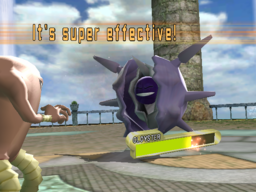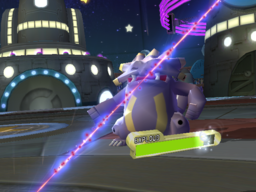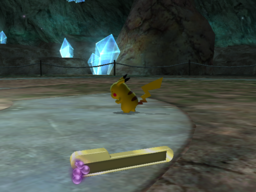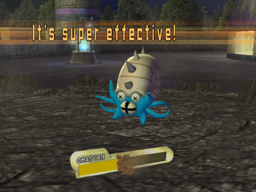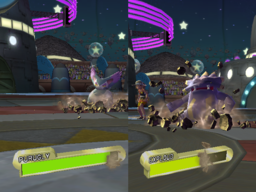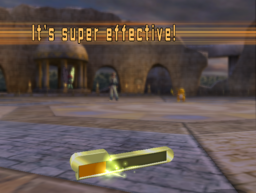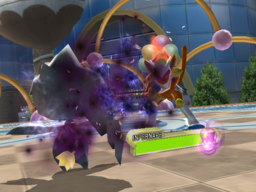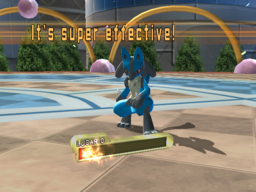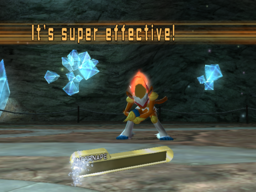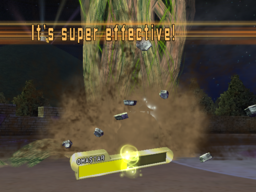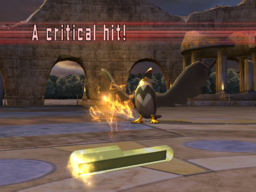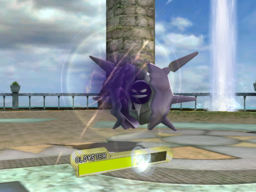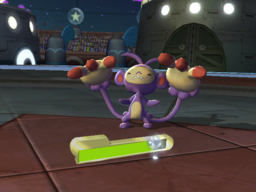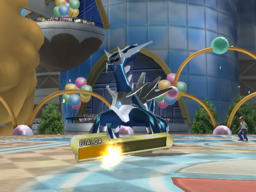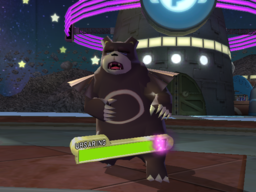Damage

Damage (Japanese: ダメージ damage) is a loss of a Pokémon's HP that happens as the result of a special or physical attack used against it by another Pokémon.
Damage modification
Damage modification is a system of multipliers used to change the damage dealt in a battle. These modifiers affect how the damage is calculated by multiplying the move's base power in various ways. These modifiers range from doubling to halving and even negating the damage done.
Type effectiveness
Since each move has a type, its effectiveness (Japanese: 効果 effectiveness) is largely determined by the targeted Pokémon's type. Moves can have regular effectiveness or be super effective, not very effective, or not effective at all. The effectiveness of types against one another has varied among generations, see this page.
Super effective
- "Super effective" redirects here. For the webcomic, see Super Effective (webcomic).
- "It's super effective" redirects here. For the podcast, see It's Super Effective (podcast).
- "Weakness" redirects here. For the TCG mechanic, see Appendix:Glossary (TCG) → Weakness.
When a move is super effective (Japanese: 効果はバツグン super effective), it inflicts double the damage it would normally do. For example, a move like Megahorn used against a Psychic-type Pokémon will be super effective because Bug-type moves are super effective against Psychic types. This effect can stack up; for example, a Pokémon that is Rock/Ground and is hit by a Water-type move like Surf will be damaged four times as much by the move as a Normal-type Pokémon would be, because both Rock and Ground Pokémon are weak to Water moves.
In Pokémon GO, super effective moves deal only 1.25x the damage, instead of 2x.
Not very effective
- "Resistance" redirects here. For the TCG mechanic, see Appendix:Glossary (TCG) → Resistance.
When a move is not very effective (Japanese: 効果は今一つ not very effective), or resistant, it deals half of the damage it would normally do. This works exactly like super effective moves, and can stack up. For example, a Steel/Rock Pokémon will be damaged by a quarter of the amount by a Normal-type move. Likewise, a Normal/Flying Pokémon hit by a Fighting-type move will be damaged normally, as Normal's weakness to Fighting is canceled out by Flying's resistance to it.
In Pokémon GO, not very effective moves deal 0.8x damage, instead of 0.5x.
Not effective
When a move is not effective (Japanese: 効果がない not effective), it does not damage the Pokémon at all and that Pokémon is "immune" to all attacks of that type; the move will yield a message of "It doesn't affect Pokémon..." Certain types are also immune to specific status moves, such as Ground-type Pokémon being immune to the Electric-type Thunder Wave, or Grass-type Pokémon being immune to Leech Seed as well as powder and spore moves.
In Pokémon GO, not effective moves are treated as if they are not very effective. So a Ground-type move can hit a Flying-type Pokémon, only at 0.8x damage.
Critical hit
- Main article: Critical hit
A move will sometimes inflict a critical hit against another Pokémon. This will increase the damage done by 1.5× (2× prior to Generation VI) prior to type effectiveness calculations.
From Generation II onward, critical hits cause the effects of Light Screen and Reflect to be ignored. From Generation III onward, a critical hit additionally causes the attacker's negative stat changes and the defender's positive stat changes to be ignored.
There are no critical hits in Pokémon GO.
Same-type attack bonus
- Main article: Same-type attack bonus
A move used by a Pokémon that is of the same type as the move itself will do 150% of its normal damage, such as a Fire-type move used by a Fire-type Pokémon. Dual-type Pokémon will receive this bonus for both of their types, and a Pokémon whose type can change in-battle will receive the bonus for whatever type they are when they make the move. Pokémon with Adaptability have this increased to 200% (an effective boost of ~33.3%).
In Pokémon GO, the same-type attack bonus is 1.25x, instead of 1.5x.
Weather
- Main article: Weather
Water-type and Fire-type moves' damage will be modified by rain and harsh sunlight. During rain, Water-type moves do 50% more damage and Fire-type moves do 50% less damage. During harsh sunlight, Fire-type moves do 50% more damage and Water-type moves do 50% less damage.
Abilities
- Main article: Ability
Abilities come in a wide variety, and have various effects on damage modification. These effects range from increasing and decreasing the power of moves of a specific type, granting immunities, and even changing the power of moves affected by other damage modifiers. These Abilities include:
- Blaze, Overgrow, Torrent and Swarm increase the power of Fire-type, Grass-type, Water-type and Bug-type moves respectively by 50% when the user's HP falls below 33%.
- Guts will increase the user's Attack by 50% if inflicted with a burn, paralysis, or poison.
- Thick Fat decreases the damage dealt to the user by opponents' Fire-type and Ice-type moves by 50%. Heatproof decreases the damage dealt to the user by opponents' Fire-type moves by 50%.
- Levitate provides immunity to Ground-type moves, Soundproof provides immunity to sound-based moves, and Bulletproof provides immunity to ball and bomb moves.
- Volt Absorb and Water Absorb grant immunity to Electric-type and Water-type moves respectively, healing the user's HP by 25% instead.
- Dry Skin works in part like Water Absorb, healing the user when hit with a Water-type move, but it also heals the user by 6.25% each turn during rain. However, it also causes the Pokémon to receive additional damage from Fire-type attacks and lose 6.25% of its HP in damage during sunlight.
- Flash Fire negates the effect of opponents' Fire-type moves and instead increases the power of the ability's user's own Fire-type attacks. Similarly, Motor Drive negates the effect of opponents' Electric-type moves and instead increases the user's Speed by one stage. These abilities include status moves like Will-O-Wisp and Thunder Wave.
- Mold Breaker, Teravolt, and Turboblaze remove all ability-based immunities to the user's moves.
- Scrappy allows the user to hit Ghost-types with Normal-type and Fighting-type damage-dealing moves.
- Adaptability increases the STAB multiplier for moves of the same type as the user from 1.5× to 2×.
- Hustle boosts the Attack stat of the user by 50%.
- Pure Power and Huge Power both double the user's Attack stat.
- Technician increases the power of the user's moves with base power 60 or less by 50%.
- Super Luck increases the user's critical hit ratio.
- Battle Armor and Shell Armor prevent critical hits being dealt to the user.
- Sniper increases the damage of a user's critical hits by 50%.
- Tinted Lens doubles the power of the user's moves that are not very effective.
- Solid Rock and Filter each reduce the power of super effective moves on the user by 25%.
- Wonder Guard gives the user immunity to all attacking moves that are not super effective.
- Iron Fist increases the damage of punching moves by 20%.
- Mega Launcher increases the damage of aura and pulse moves by 50%.
- The moves Storm Throw and Frost Breath can cancel out the 50% damage if used on certain types due to the moves always resulting in a critical hit, and can cause 4×, 6× or 12× multipliers if used on other types.
Items
- See also: Type-enhancing item
Some held items increase the power of an attack by a small percentage. Most of these items boost attacks only of a certain type by 20%. Some items can also modify damage by boosting the attacker's offensive stats or the victim's defensive stats. Some Berries also weaken an opponent's super-effective move.
Other held items that modify damage include:
- Muscle Band boosts physical moves by 10%
- Wise Glasses boost special moves by 10%
- Expert Belt boosts super-effective attacks by 20%
- Life Orb boosts the power of all attacks by 30% (at a cost of 10% HP per damaging move used)
- Metronome boosts the power of moves used repeatedly
Other
A number of other variables can affect the amount of damage caused by an attack.
- If the attacker is burned and their Ability is not Guts, their physical damage will be decreased by half.
- In a Double Battle, moves that hit multiple targets do 75% of the damage they do in one-on-one battles.
- Reflect and Light Screen decrease opponents' physical and special attacks, respectively, by 50% in a one-on-one battle and 33% in a Double Battle.
Randomization adjustment
Every time a regular attack is executed, the actual damage caused is adjusted by a random multiplier - an integer percentage between 85% and 100%.
In Generations I and II, the random modifier is not an integer percentage. Instead of selecting a 4-bit integer, the game selects a random byte (that is, a value up to 255), repeatedly selecting a new one until the selected value is 217 or greater; the game afterwards multiplies the pre-adjustment damage by this number and divides it by 255. As a result, the randomization adjustment in these two generations goes between 217/255 (roughly 85.1%) and 255/255 (100%) in steps of 1/255, giving each value a uniform 1 in 39 chance of being selected (as opposed to 1 in 15 in later generations).
In all subsequent games, the random adjustment is determined by generating a 4-bit integer (0 through 15). The computer then subtracts it from 100, and then divides the result by 100 to get the final adjustment. This results in an integer percentage between 85% and 100%, with a uniform distribution.
Damage formula
The damage dealt when a Pokémon uses a damaging move depends on its Attack or Special Attack stat, the opponent's corresponding Defense or Special Defense stat, and the move's base power. In addition, the various factors of damage modification will also affect the damage dealt.
The damage formula is
where
- Level is the level of the attacking Pokémon.
- Attack and Defense are the working Attack and Defense stats of the attacking and defending Pokémon, respectively. If the attack is Special, the Special Attack and Special Defense stats are used instead. Some moves like Psystrike use stats other than what moves of this category would usually use (in case of Psystrike, it uses Special Attack and Defense).
- Base is the base power of the attack.
and Modifier is
where
- STAB is the same-type attack bonus. This is equal to 1.5 if the attack is of the same type as the user, and 1 if otherwise.
- Type is the type effectiveness. This can be either 0, 0.25, 0.5, 1, 2, or 4 depending on the type of attack and the type of the defending Pokémon.
- Critical is 2 for a critical hit in Generations I-V, 1.5 for a critical hit from Generation VI onwards, and 1 otherwise.
- other counts for things like held items, Abilities, field advantages, and whether the battle is a Double Battle or Triple Battle or not.
- random is a random number from 0.85 to 1.00.
The result is rounded down as remainders are not kept. In Generations I and V only, it is possible to deal zero damage[1], due to apparent programming oversights.
Example
Imagine a level 75 Glaceon that has the following stats:
HP: 201
Attack: 123
Defense: 181
It uses the move Ice Fang (Ice, physical, base power 65) against a level 78 Garchomp:
HP: 270
Attack: 210
Defense: 163
Garchomp is Dragon/Ground, so it has a double weakness to Ice. Thus, Type = 4. Additionally, Glaceon, being an Ice-type, receives STAB, so STAB = 1.5.
Modifier is then plugged into the rest of the formula:
So depending on luck, Glaceon will do damage in the range 170-200 HP. Despite Garchomp's double weakness to Ice, Glaceon's Ice Fang will not defeat it in a single hit.
Garchomp is up next. Garchomp gets a critical hit (Critical = 2) on Earthquake, a physical Ground move with 100 base power. With its Ice type, Glaceon is neither weak nor resistant to Garchomp's attack, so Type = 1. Garchomp is Dragon/Ground, so it receives STAB, making STAB = 1.5. Say that Garchomp is also holding an Earth Plate, which powers up Ground-type moves by 20%. Then Other = 1.2.
Inserting the stats and Modifier in the formula yields:
Garchomp's attack will do anywhere from 241 to 284 damage, which is more than enough to take the Glaceon out in one hit.
Trivia
- The highest potential damage dealt in a single attack can be achieved by Shuckle using Ice Ball.
- In Pokémon Battle Revolution, the HP bar will change with a different animation depending on the move's type (recovery, recoil damage and indirect damage use the Normal-type animation), as shown below.
|
In other languages
| ||||||||||||||||||||||||||||||||||||||
External links
References

|
This game mechanic article is part of Project Games, a Bulbapedia project that aims to write comprehensive articles on the Pokémon games. |

